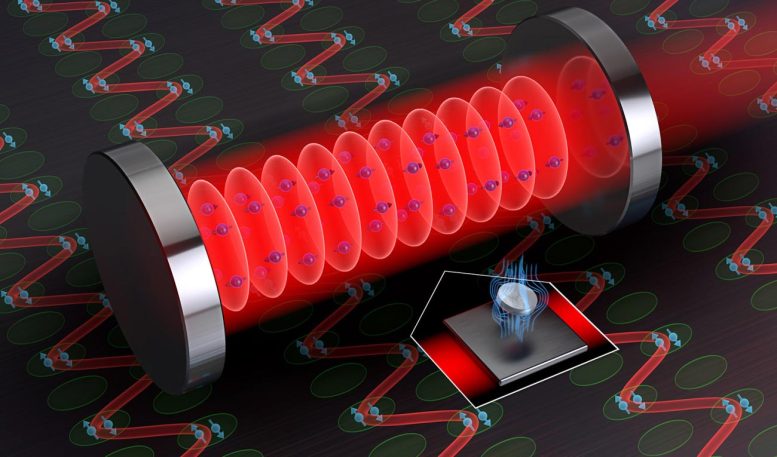
Researchers observed the dynamic phases of BCS superconductor interactions in a Cavity QED by measuring the light leakage from the cavity. Credit: Steven Burrows/Rey and Thompson Groups
Researchers at JILA simulated superconductivity in strontium atoms within an optical cavity to observe rare dynamic phases, including the elusive Phase III, which has implications for quantum physics and technology development.
In physics, scientists have been fascinated by the mysterious behavior of superconductors—materials that can conduct electricity with zero resistance when cooled to extremely low temperatures. Within these superconducting systems, electrons team up in “Cooper pairs” because they’re attracted to each other due to vibrations in the material called phonons.
As a thermodynamic phase of matter, superconductors typically exist in an equilibrium state. But recently, researchers at JILA became interested in kicking these materials into excited states and exploring the ensuing dynamics. As reported in a new Nature paper, the theory and experiment teams of JILA and NIST Fellows Ana Maria Rey and James K. Thompson, in collaboration with Prof. Robert Lewis-Swan at the University of Oklahoma, simulated superconductivity under such excited conditions using an atom-cavity system.
Instead of dealing with actual superconducting materials, the scientists harnessed the behavior of strontium atoms, laser-cooled to 10 millionths of a degree above absolute zero and levitated within an optical cavity built out of mirrors. In this simulator, the presence or absence of a Cooper pair was encoded in a two-level system or qubit. In this unique setup, photon-mediated interactions between electrons were realized between the atoms within the cavity.
Thanks to their simulation, the researchers observed three distinct phases of superconducting dynamics, including a rare “Phase III” featuring persistent oscillatory behavior predicted by condensed matter physics theorists but never before observed.
These findings could pave the way for a deeper understanding of superconductivity and its controllability, offering new avenues for engineering unique superconductors. Moreover, it holds promise for enhancing the coherence time for quantum sensing applications, such as improving the sensitivity of optical clocks.
Identifying Superconducting Phases
The JILA team focused on simulating the Barden-Cooper-Schrieffer model, which describes the Cooper pair behavior. As co-first author and JILA graduate student Dylan Young elaborated: “The BCS model has been around since the 1950s and is central to our understanding of how superconductors work. When condensed matter theorists began studying the out-of-equilibrium dynamics of superconductors, they naturally started with this model.”
In the past few decades, condensed matter theorists have predicted three distinct dynamical phases for a superconductor to experience when it evolves. In Phase I, the strength of superconductivity decays rapidly to zero. In contrast, Phase II represents a steady state in which superconductivity is preserved.
However, the previously unobserved Phase III is the most intriguing. “The idea of phase III is that the strength of superconductivity has persistent oscillations with no damping,” explained JILA graduate student and co-first author Anjun Chu. “In the phase III regime, instead of suppressing the oscillations, many-body interactions can lead to a self-generated periodic drive to the system and stabilize the oscillations. Observing this exotic behavior requires precise control of experimental conditions.”
To observe this elusive phase, the team leveraged the collaboration of theory from Rey’s group and experiment from Thompson’s group to create a precisely controlled experimental setup, hoping to fine-tune the experimental parameters to achieve Phase III.
Creating Precise Simulations in a Cavity Setting
While researchers previously tried to observe Phase III in real superconducting systems, measuring this phase has remained elusive due to technical difficulties. “They didn’t have the right ‘knobs’ or readout mechanisms,” explained Young. “On the other hand, our implementation in an atom-cavity system gives us access to both tunable controls and useful observables to characterize the dynamics.”
Building on previous work, the researchers trapped a cloud of strontium atoms within an optical cavity. In this “quantum simulator’’, the atoms emulated Cooper pairs and experienced a collective interaction that parallels the attraction experienced by electrons in BCS superconductors. “We think of each atom as representing a Cooper pair,” Young explained. “An atom in the excited state simulates the presence of a Cooper pair, and the ground state represents the absence of one. This mapping is powerful because, as atomic physicists, we know how to manipulate atoms in ways you just can’t with Cooper pairs.”
The researchers applied this knowledge to induce different phases of dynamics in their simulation by a process known as “quenching.” As Young elaborated: “Quenching is when we suddenly change or ‘kick’ our system to see how it responds. In this case, we prepare our atoms in this highly collective superposition state between ground and excited states. Then, we induce a quench by turning on a laser beam that gives all the atoms different energies.”
By changing the nature of this quench, the researchers could see different dynamical phases. They even devised a trick to observe the elusive Phase III, which involved splitting the cloud of atoms in half. “Using two clouds of atoms with separate control over energy shifts is the key idea to achieve Phase III,” Chu remarked.
In superconductors, energy levels of electrons can be split into two sectors, largely occupied or barely occupied, separated by the Fermi level. “Our setup in spin systems does not have a Fermi level intrinsically, so we take account of this using two atomic clouds: one cloud simulates the states below the Fermi level, while another cloud simulates the other [quantum] states,” Chu added.
To measure the dynamics of the superconductor within the cavity, the researchers tracked the light leaking from the optical cavity in real time. Their data found distinct points where the simulated superconductor transitioned between phases, eventually reaching Phase III.
Seeing the first measurements of Phase III surprised many of the team. As Thompson stated: “Actually seeing the wiggles was extremely satisfying.” For her part in the collaboration, Rey was just as excited to see the theory and experiment align. “On the theory side, BCS superfluids/superconductors could, in principle, be observed in actual degenerate fermionic gases, such as the ones Debbie Jin at JILA taught us how to create. However, it has been hard to observe the dynamical phases in these systems. We predicted back in 2021 that all BCS dynamical phases could instead manifest in an atom-cavity experiment. It was so nice to see our theory predictions become a reality and actually observe the dynamical phases in a real experiment!”
Underlying Physics with Broader Applications
While observing Phase III within their system was a significant achievement, the team also found that the measured behaviors could have wider implications beyond superconductivity. As Thompson elaborated, “In terms of the underlying model that you use to describe it, it turns out that this BCS model has all these connections to different types of physics at different energy scales, temperature scales, and timescales, from superconductors to neutron stars to quantum sensors!”
Rey added: “These observations really open a path to simulate unconventional superconductors with fascinating topological properties for realizing robust quantum computers. It will be fantastic to emulate even toy models of these complex systems in our atom-cavity quantum simulator.”
For more on this research, see Strontium Unlocks Quantum Secrets of Superconductivity.
Reference: “Observing dynamical phases of BCS superconductors in a cavity QED simulator” by Dylan J. Young, Anjun Chu, Eric Yilun Song, Diego Barberena, David Wellnitz, Zhijing Niu, Vera M. Schäfer, Robert J. Lewis-Swan, Ana Maria Rey and James K. Thompson, 24 January 2024, Nature.
DOI: 10.1038/s41586-023-06911-x
This work was supported in part by the Quantum Systems Accelerator, part of the US Department of Energy, Office of Science, National Quantum Information Science Research Centers.

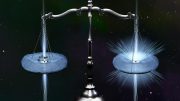


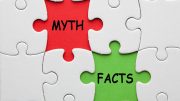

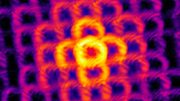

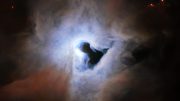
The collaboration of minds in open expressions of distinction and direction forge the greatest amount of wonder of seeing for the first time, akin to the birth of awareness in a child, always congratulate those who add to their understanding through friendship.
What is the physical essence of the coherence time for quantum sensing applications? Science must eliminate falsehood and preserve truth. The things that researchers can observe in experiments are always superficial phenomena, not essential.
According to topological vortex gravitational field theory, spin creates everything, spin creates the world, spin creates the future. In the interaction of topological vortices, time is both absolute and relative,and physics often requires treating space and time at the same level. Spin generates time, spin generates gravitation, spin generates energy, spin generates evolution. Each topological vortex is a quantum clock. Starting from the formation of topological vortices, precise timing begins.
The interaction and balance of topological vortices not only demonstrate the beauty of mathematics, but also change the way humanity understand nature. Studying topological vortices can greatly expand the boundaries of humanity cognition.
All observable movements in the physical world are inseparable from the interaction of topological vortices, including human observational behavior itself.
The universe does not do algebra, formula or fraction. The universe is geometrythe, and is the superposition, deflection, and twisting of geometric shapes.
Today, we have already entered the era of the internet. With the help of artificial intelligence and big data, discussions on scientific knowledge have become open and transparent. However, a group of editors of so-called academic journals (such as Physical Review Letters, Nature, Science, etc.) are self righteous, self proclaimed, fooling the public, lack remorse, and mystifying themselves. They only care about their own so-called sufficiently high priority rating, general significance, discipline, novelty, etc., and do not care about what science and pseudoscience are.
Science and pseudoscience are not determined by a publication, an organization or a person, nor by you or me, but by mathematics the final say. Physical models must be based on mathematics or mathematical models in order to be scientific, convincing, and in accordance with natural laws.
The origin of geometry lies in the concerns of everyday life. The branch of geometry (mathematics) known as topology has become a cornerstone of modern physics. Topological vortex and antivortex are two bidirectional coupled continuous chaotic systems. They exhibit parity conservation, charge conjugation, and time reversal symmetry. The synchronization effect is extremely important in their interactions. The synchronization effect of the superposition, deflection, and twisting of multiple or countless topological vortices will make spacetime motion more complex. To understand this complex world, physics should respect the authenticity of topological vortex in low dimensional spacetime, rather than simply relying on a few formulas, numbers, or imagined particles.
Spin is a natural property of topological vortices. Spin is synchronized with energy, spin is synchronized with gravitation, spin is synchronized with time, spin is synchronized with evolution. The perpetually swirling topological vortices defy traditional physics’ expectations. One physical properties of topological vortices is them to spontaneously begin to change periodically in time, even though the system does not experience corresponding periodic interference. Therefore, in the interaction of topological vortices, time is both absolute and relative,and physics often requires treating space and time at the same level.
Low-dimensional spacetime matter is the foundation of high-dimensional spacetime matter. Low-dimensional spacetime matter (such as topological vortex) can form new material structures and derive more complex physical properties via interactions and self-organization. It is extremely wrong and irresponsible to imagine low dimensional spacetime matter using high-dimensional spacetime matter,such as a cat in quantum mechanics.
Science must follow mathematical rules. For example, the Standard Model (SM) is considered to be one of the most significant achievements of physics in the 20th century. However, the magnetic moment of μ particle is larger than expected, revealed by a g-2 experiment at Fermilab, suggests that the established theory (such as SM) of fundamental particles is incomplete. Furthermore, the SM omitting gravitation, it not involved the time problem and when the particle movement starts. Mathematics is the foundation of science. Physics must respect the scientific nature of mathematics and mathematical models. The SM must be based on mathematical models in order to be scientific, convincing, and in line with natural laws.
I hope researchers are not fooled by the pseudoscientific theories of the Physical Review Letters (PRL), and hope more people dare to stand up and fight against rampant pseudoscience.
The so-called academic journals (such as Physical Review Letters, Nature, Science, etc.) firmly believe that two high-dimensional spacetime objects (such as two sets of cobalt-60) rotating in opposite directions can be transformed into two objects that mirror each other, is a typical case of pseudoscience rampant.
If researchers are really interested in Science and Physics, you can browse https://zhuanlan.zhihu.com/p/643404671 and https://zhuanlan.zhihu.com/p/595280873.
The Physical Review Letters (PRL) is the most evil, ugly, and dirty publication in the history of science. Nature and Science have been influenced by Physical Review Letters (PRL) and are even more notorious. The behavior of these pseudo-academic publications has seriously hindered the progress and development of human society in science and technology.
I am well aware that my relentless repetition can make some people unhappy, but in the fight against rampant pseudoscience, that’s all I can do.